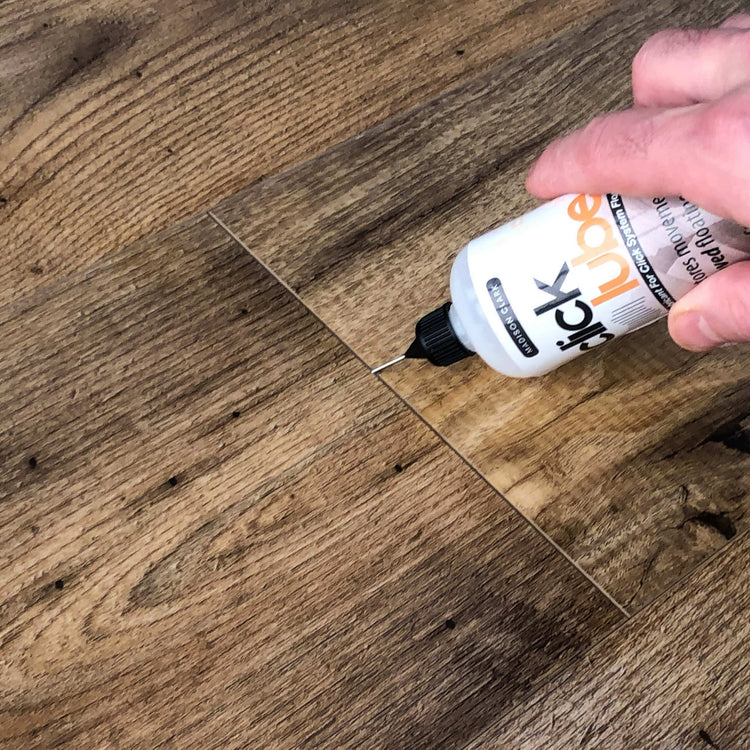A silent home is often disturbed by a singular, disquieting sound: a creaking laminate floor beneath one's feet.
In quiet contemplation, the creak seems almost a herald of unseen issues lurking beneath the surface.
Yet, to the well-informed, each groan presents not a mystery but a clue, a silent narrative unfolding within the layers of one's domicile.
Common Causes of Floor Creaking
Laminate flooring's allure lies in its sleek appearance and the promise of easy maintenance; however, its harmony can be disrupted by an intermittent chorus of creaks. This phenomenon usually stems from the floor's reaction to climatic changes, resulting in the expansion and contraction of materials. Such movements can cause friction between planks or against the subfloor, typically manifesting as the creaks that disturb the tranquility of a room.
Instability is another culprit behind the unsettling symphony of a creaking floor, typically emerging from an inadequately prepared subfloor or an uneven foundation below. This unevenness allows for minute movements within the laminate's floating system – designed to accommodate slight shifts – that can translate into audible creaks. Additionally, the passage of time may lead to the loosening of the floor's interlocking mechanisms, further contributing to the cacophony underfoot.
Subfloor Imperfections
The integrity of laminate flooring is contingent upon a flawlessly level subfloor, the bedrock upon which the laminate lies.
An impeccably flat surface ensures uniform weight distribution, reducing stress on the laminate, thus decreasing the potential for creaking.
Yet a subfloor marred with deviations can lead to unequal force exertion on the laminate segments. Over time, this imbalance causes the floorboards to shift and settle, typically resulting in that disconcerting creak as one traverses the room.
Untreated subfloor imperfections can act as harbors for persistent creaking—akin to a craftsman’s neglect for a painting's canvas—thereby negating the seamless aesthetics and function one seeks in laminate flooring.
Climate and Moisture Effects
Laminate flooring is exceedingly sensitive to the ambient humidity and temperature levels within an environment. Becoming acutely aware of such climatic factors is paramount for the sustainability of your flooring.
Substantial climatic fluctuations can provoke the laminate materials to expand or contract. As these changes occur, the once snugly fit planks may begin to distend or retract, leading to gaps or overlaps, which typically manifest as creaking sounds underfoot.
In periods of elevated humidity, laminate floors absorb moisture from the air, engendering an expansion that can compel the planks to press against each other and the walls. This pressure buildup catalyses friction among laminate segments, culminating in the audible distortion known as floor creaking.
Conversely, during times of low humidity, the laminate material may shrink, generating voids between planks that yield a concavity within which movement produces the disquieting creaks. Investing in a hygrometer to monitor room humidity may help mitigate such issues.
Maintaining a stable climate within your interior spaces can thus profoundly impact the longevity of your laminate flooring, averting the nuisances of expansion and contraction that lead to creaking.
Laminate Locking System Issues
Laminate floors utilize a precise locking mechanism, which, if compromised, may result in creaking.
- Improper Installation: Misalignment during installation can cause locking mechanisms to disengage.
- Wear and Tear: Over time, the locking system can deteriorate, leading to plank movement.
- Subfloor Irregularities: Uneven subfloors can apply uneven pressure on the locking system.
- Expansion and Contraction: Temperature and humidity fluctuations can distort the lock fit.
- Inadequate Acclimatisation: Failing to acclimatize laminate planks’ pre-installation affects lock integrity.
A well-executed installation is paramount to prevent audible disturbances.
Faulty locking systems emerge when these planks are no longer correctly interconnected. This misalignment may lead to friction and the unsettling sounds of creaking as the pieces shift against one another.
Installation-Related Issues
Poorly calibrated underlay can undermine a laminate floor's integrity, leading to excessive movement and subsequent creaking. Imperfections during installation, such as failure to leave adequate expansion gaps at the room's perimeter, can amplify these disturbances over time.
Unevenly distributed glue or incorrect underlay selection can further exacerbate the creaking issue. Disparities in these installation elements create areas of instability, translating into audible indicators of a compromised flooring system.
Inadequate Expansion Gaps
Laminate flooring demands meticulous consideration to expansion gaps.
Substantial environmental temperature and humidity changes inevitably cause laminate planks to expand or contract. Provisioning insufficient expansion gaps during installation can precipitate floor creaking. Expansion gaps serve as vital allowances for the laminate's natural movement.
In the absence of suitable expansion clearances, laminate boards may press against one another. This excessive pressure fosters friction and constriction, impairing the floor's capacity to move freely. Consequently, the creaking noise emerges as evidence of the planks' resistance to the spatial constraints.
Notably, expansion gap negligence is more pronounced where flooring meets fixed structures. Ensuring consistent gap allocation at walls, thresholds, and around fixtures is indispensable. Ignorance of this critical consideration can lead to the audible irritation of a creaking laminate floor.
Effective expansion management also involves appropriate trim installation. Without the correct placement and use of skirting or quarter rounds, gaps may become compromised. These finishing touches are not merely cosmetic – they secure the requisite spacing to preserve a silent, fully-functional floor.
Addressing inadequate expansion gaps post-installation can be complex. It may necessitate partial floor disassembly to rectify. In such cases, engaging with a flooring specialist is recommended to ameliorate the issue without compromising the floor's integrity.
Poorly Laid Underlay
The underlay plays a pivotal role in absorbing sounds and providing a smooth surface for the laminate flooring.
- Inconsistent Thickness: Disparate underlay thickness can cause an uneven floor that's prone to creaking.
- Improper Installation: Failure to follow the manufacturer's instructions may result in gaps or overlaps.
- Substandard Material Quality: Low-grade underlay often lacks adequate sound absorption capabilities.
- Lack of Moisture Barrier: In the absence of a proper moisture barrier, the underlay may deteriorate, contributing to noise.
- Misalignment with Floor Joists: An underlay that is not correctly aligned with the floor joists may lead to instability.
An inadequate underlay can also contribute to premature wear of the floor surface.
To counteract this, it's imperative that professionals are engaged to ensure the underlay is appropriately selected and installed.
Age-Related Floor Changes
As laminate flooring matures, it naturally undergoes physical changes due to wear and environmental influences. For instance, as years pass, the interlocking mechanisms of laminate planks may lose their initial tightness. This loss of grip between planks can result in undesirable movement and, consequently, that unsettling creaking sound often heard underfoot.
Compounding the issue are the subtle shifts in the subfloor itself, which develop over time, known as "settling." Changes in humidity, temperature, and structural integrity can all contribute to a floor's gradual distortion. As the subfloor contorts, it can alter the support beneath the laminate. If the interplay between the laminate and the evolving subfloor becomes sufficiently discordant, the dissonance manifests as the creaks and groans you may notice when navigating across the room.
Wear and Tear Over Time
Laminate flooring is a fusion of multiple layers pressed together; hence, it is not impervious to the slow degradation that all material objects encounter through extended use and time.
Initially, the damage may be microscopic, invisible to the naked eye—a diminutive deforming of the edges or a gentle warping of individual planks. Yet, these minute alterations accrue, leading to more significant discrepancies between the connection points. As planks become misshapen from sustained stress and traffic, the once-snug fit loosens, facilitating the audible evidence of wear: creaking.
Furthermore, daily activities exiguous as they may seem, contribute to the cumulative toll on your laminate flooring. Heavy furniture, frequently trafficked paths, and even the persistent impact of footsteps can strain the floor's resilience, incrementally exacerbating the creaking phenomenon as materials fatigue and distort.
Finally, the surfaces in our homes bear silent witness to our lives' myriad moments, and over time, they too tell a tale of the years that pass. As the protective wear layer of the laminate begins to thin from repeated cleaning and friction, it offers less defense against the wear-induced movement, thereby reducing the floor's ability to muffle the sounds of our comings and goings. Continuous use and maintenance can inadvertently accelerate material fatigue, thereby contributing to the inescapable reality of a creaking laminate floor.
Adhesive Breakdown
Adhesive failure can precipitate laminate floor creaking.
When floors are laid, adhesives play a critical role in securing laminate tiles or planks to the subfloor. Over time, these adhesives can deteriorate due to environmental factors, wear and tear, or inferior application quality, leading to a loss of bonding integrity which manifests as creaking. Importantly, correct product selection and competent installation are critical to avoiding adhesive breakdown.
Subfloor moisture influences adhesive longevity significantly.
Repeated exposure to high levels of moisture – be it from subfloor dampness or cleaning activities – can undermine and break down adhesive substances. Moreover, inadequate moisture barriers can exacerbate this effect, leading to a decline in floor stability.
Persistent creaking may signal adhesive failure interventions.
When a detailed examination reveals no structural defects or issues arising from installation or environmental conditions, one should consider the possibility of adhesive degradation. If suspected, professional assessment and remediation may be required to address the underlying issues and restore the laminate floor to its quietly supportive role.
Remedial Steps for Quiet Flooring
In addressing the unsettling creaks emanating from laminate flooring, one might consider employing a variety of targeted remedial measures. Ensuring the subfloor is level, using appropriate underpayment materials, and addressing any moisture concerns are foundational steps in restoring serenity. Occasionally, it may be necessary to re-secure loose planks either through reapplication of adhesives or tightening of the locking mechanisms.
Where adhesive failure is indicated, the employment of a specialist to assess and repair the compromised area is advisable. Thorough and precise remediation can arrest the decline in laminate floor stability, thus reinstating its integral role in providing a peaceful and noise-free living environment.
Professional Assessments
Professional evaluations are crucial when tracing the origins of laminate floor creaking.
- Inspection of Subfloor Integrity: Determining if imperfections or unevenness contribute to movement and noise.
- Examination of Laminate Planks: Assessing for any damage or wear that may cause planks to move incorrectly.
- Moisture Level Assessment: Ensuring the absence of excess humidity that compromises adhesive and material integrity.
- Underlayment Condition Appraisal: Investigating the quality and installation adequacy of the barrier between subfloor and laminate.
- Assessment of Installation Technique: Verifying whether the original fitting process adheres to best practices.
Identification of issues by experts can inform targeted interventions.
Specialist intervention may be required to remedy identified shortcomings.
DIY Repair Techniques
Locate and identify the creaking planks.
Before engaging in repair efforts, diagnosing the precise location of the creaking is paramount. Encumbrances within the room must be temporarily relocated to provide unimpeded access to the laminate surface. Once the affected area is clear, apply gentle pressure along the planks to discern which emit the problematic sounds.
Determine the cause of the creak.
To ascertain the underlying issue, inspect the immediate environment. Common catalysts for floor creaking include humidity-induced expansion, substandard installation techniques, and the aging process of the materials themselves.
Explore quick-fix solutions.
In situations with a clear diagnosis, temporary repairs may suffice – for instance, using talcum powder to alleviate minor friction between planks.
Use professional-grade materials for lasting repairs.
For a more enduring solution, invest in materials exclusively designed for flooring repair. These may encompass adhesives, expandable foams, or kits specifically crafted for laminate repair.
Consult expert resources for guidance.
Should the repair process appear daunting, refer to industry literature or online tutorials for assistance. Up-to-date guidelines and recommendations are routinely published, facilitating informed and effective interventions for homeowners. Consider resources such as those provided by the National Wood Flooring Association (NWFA) or video tutorials from prominent flooring manufacturers.

